BIOCOMPATIBILITY OF DENTAL MATERIALS

davidgibson + Follow
Download Presentation
BIOCOMPATIBILITY OF DENTAL MATERIALS
An Image/Link below is provided (as is) to download presentation Download Policy: Content on the Website is provided to you AS IS for your information and personal use and may not be sold / licensed / shared on other websites without getting consent from its author. Content is provided to you AS IS for your information and personal use only. Download presentation by click this link. While downloading, if for some reason you are not able to download a presentation, the publisher may have deleted the file from their server. During download, if you can't get a presentation, the file might be deleted by the publisher.
Presentation Transcript
- BIOCOMPATIBILITY OF DENTAL MATERIALS DR.RAMASHANKER Associate professor Deptt. of prosthodontic 3rd nov2014 time-10-11am
- Introduction History Definition Requirements Tests for evaluation Allergic responses to dental materials Materials considered for biocompatibility Physical factors affecting pulp health Summary References CONTENTS
- Introduction • Biocompatibility :- interaction between body & material • Body ↔ Material • Placement of material creates interface : dynamic • Interface activity depends on: - location of material - its duration in body - its properties - health of host
- History • Mid 1800’ s dentists tried new materials for first time by directly putting them in patient’s mouth eg. Fox : fusible metal-bismuth, lead & tin-melted & poured in cavity preparation at appx.100o C • G.V. Black tried his new ideas of restorative materials, like early amalgams in patients’ mouth
- Concept of protecting patients- early 1960’s • Regulations & ethics introduced • Organisations like FDA,ANSI,ADA and ISO .
- Being harmonious with life & not having toxic or injurious effects on biologic function. (G.P.T. 8th edn.-2005) Ability of the material to elicit an appropriate biological response in a given application in the body (Kenneth J.A). Definition
- Should not be harmful to pulp & soft tissues Should not contain toxic diffusible substances Should not produce allergic responses Should not be carcinogenic Requirements for Dental Material Biocompatibility
- Any substance, other than a drug, that can be used for any period as a part of a system that treats, augments, or replaces any tissue, organ or function of the body. (G.P.T. 8th edn.-2005) Biomaterial
- Those which contact soft tissues within the oral cavity eg. Acrylic resin Those which could affect health or vitality of pulp eg. Liner, bases Those which are used as root canal filling materials eg. Gutta percha Classification of Biomaterials from perspective of Biocompatibility
- Those which affect hard tissues of oral cavity eg. Implants Those used in dental laboratory eg. Nickel, chromium, cobalt Classification of Biomaterials from perspective of Biocompatibility
- Classical biological reactions to materials are : TOXICITY INFLAMMATION ALLERGY MUTAGENICITY ADVERSE EFFECTS FROM DENTAL MATERIALS
- Earliest response studied Earlier material containing LEAD posed a risk to patient due to toxic property of lead TOXICITY
- Involves activation of the host immune system Histologically it is characterized by edema of the tissue with infiltration of acute & chronic inflammatory cells INFLAMMATION
- Most common response that occurs when the body recognizes a material as foreign Reactions involves all dimensions of immune system An allergic reaction results histologically in an inflammatory response that can be difficult to differentiate between non allergic inflammation or low grade toxicity . ALLERGY
- Allergy
- Allergic Responses to Dental Materials • Allergic Contact Dermatitis • Allergic Contact Stomatitis • Allergy to Latex products
- Most common occupational disease Susceptibility & prior sensitization necessary Dose independent Allergic Contact Dermatitis
- Allergic Contact Dermatitis • Usually occurs where body surface makes direct contact with allergen. eg. Monomers of bonding agent- distal part of fingers & palmer aspect of fingertips • Acrylic component of dental cements, nickel & resin monomers-allergic contact sensitizers.
- Most definitive diagnostic test Suspected allergen applied to skin to produce small area of allergic contact dermatitis After 48 to 96 hrs hyperemia, edema, vesicle formation & itching Positive reaction (Slavin and Ducomb,1989) Patch Test
- Allergic Contact Stomatitis • Most common adverse reaction to Dental Materials A) Local/contact type lesions B) Systemic/distant lesions
- Common allergens :- chromium, cobalt, mercury, eugenol, components of resin based materials, & formaldehyde Mouthwashes, dentifrices, lozenges, & cough drops cause burning, swelling & ulceration of oral tissues. Lichenoid reactions :- Long-term effect in oral mucous membrane adjacent amalgam & composite resins. (Bratel and Johntell,1994) Allergic Contact Stomatitis
- Allergy to Latex Products • Polyether component-main causative agent …March,1988 • Dermatitis of hand (eczema) most common adverse reaction • Localized rashes & swelling to wheezing & anaphylaxis
- Repeated exposure & duration plays important role. Most serious systemic reactions occur when gloves or rubber dam contact mucous membrane - generalized angioneurotic edema, chest pain, rash on neck or chest region and respiratory distress …Blinkhorn and Leggate,1984
- Prevention: Use Vinyl gloves or gloves made of other synthetic polymer gloves:- Polythene gloves. Powder free gloves. Nitrile gloves.
- Mutagenicity results when the components of the material alter the base pair sequences of the DNA in cells Dental materials or components such as nickel, copper, beryllium, some components of root canal sealers & resin based materials are mutagens MUTAGENIC REACTIONS
- Two key factors have paramount importance : Metal Corrosion or Metal degradation Surface Characterstics KEY PRINCIPLES THAT DETERMINE ADVERSE EFFECTS
- Biocompatibility depends on degradation process Biological response of corrosion products depends on: Amount Composition Form Location in tissues CORROSION
- Biological environment in contact also determines the corrosion property for eg: salivary esterases accelerate breakdown of dental resins Ingestion of acidic substances may alter corrosion of alloys or ceramics CORROSION
- Surface different from the Interior region For eg: casting alloy sealant EFFECTS OF SURFACE : Ti alloys promote osseointegration Rough surface promotes corrosion SURAFCE CHARATERISTICS
- Aim To eliminate any potential harm or damage to oral or maxillofacial tissues from a product or any component of a product To modify or control the use by manufacturer & operator to prevent cytotoxicity. Tests for Evaluation of Biocompatibility
- Biocompatibility tests are classified on three levels (tiers) :- Group I : Primary tests Group II : Secondary tests Group III : Usage tests Tests for Evaluation of Biocompatibility
- Group I : Primary Tests • Advantages :- • in vitro test, done in controlled experimental condition • Most rapid, economical & easily standardized • Large scale screening • Disadvantages :- • Lack of relevance to in vivo use of material • Lack of immune, inflammatory & circulatory system
- Material in a fresh or cured state → placed directly on tissue culture cells or on membranes overlying them. e.g.. Agar (Agar overlay technique) Barriers like dentin disks Cytotoxicity Tests
- Determines carcinogenic/mutagenic potential Carried out on mammalian or non-mammalian cells, bacteria, yeasts, or fungi. Evaluates gene mutations, changes in chromosomal structure & other DNA or genetic changes caused by dental materials. Genotoxicity Tests
- Ames Test :- -Material is tested with mutant histidine dependant bacteria -Agent is added to culture medium consisting salmonella typhimurium mutant gene which cannot produce histidine -If carcinogenic :- salmonella species reversed to original state, i.e. start producing histidine again Genotoxicity Tests
- Advantages :- Intact biologic system to respond to a material Provide important bridge between in vitro environment & clinical use of material Disadvantages :- More expensive & difficult to control Time consuming Ethical concerns Group II : Secondary Tests
- 1. Systemic toxicity test :- Material administered to test animals e.g.. Rats- orally or i.v. If > 50% animals survive material is safe Group II : Secondary Tests
- 2. Skin irritation test :- Irritation is inflammation without intervention of antibody or immune system. Material held in contact with shaved skin of rats for 24 to 90 days Erythema & edema are examined & confirmed. Group II : Secondary Tests
- 3. Skin Sensitization test :- Sensitization is inflammatory response requiring participation of an antibody system specific for material allergen. Done similar to irritation tests Group II : Secondary Tests
- 4. Inhalation toxicity test :- Performed on rats, rabbits or guinea pigs in exposure chamber with aerosol preparations by releasing spray material around head & upper trunk of animals. Death within 2 to 3 min. very toxic No death safe for human application Group II : Secondary Tests
- 5. Implantation test :- Only used for testing implants & endodontic materials. Material placed subcutaneously,intramuscularly, or as a bone implant at lateral cortex of femur or tibia or both Histopathological examination has to be done Observation period may be upto 1 year. Group II : Secondary Tests
- IMPLANTATION TEST
- Advantage :- Material placed in an environment clinically relevant to its use in clinical practice Disadvantages :- Extremely complex & difficult to perform Exceptionally expensive & very time consuming Ethical concerns In animals : usage tests In humans : clinical trials Group III : Usage Tests
- Classical progression of biocompatibility tests
- Newer schemes for progression of biocompatibility tests
- VARIOUS DENTAL MATERIALS CONSIDERED FOR BIOCOMPATIBILITY
- Metals : Amalgam & mercury Nickel Beryllium Gold Resins : Acrylic Resins Chemically cured composite resins Light cured composite resins
- Cements : Silicate cement Zinc Phosphate cement Glass ionomer cement Zinc oxide Eugenol cement Miscellaneous : Impression materials Implant materials
- Mercury itself has no effect on pulp Pulp response related to condensation pressure Rate of diffusion into enamel & dentin-inversely related to degree of mineralization. Amalgam & Mercury Load More .
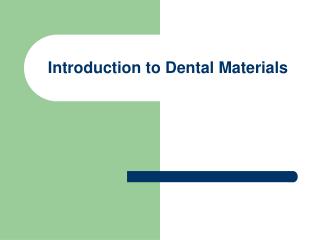
Introduction to Dental Materials
Introduction to Dental Materials. What is Dental Material?. Human body is prone to damage due to either disease or accidents. Likewise the structures in the oral cavity are lost or damaged due to disease such as caries and periodontal disease and trauma.
5.16k views • 17 slides
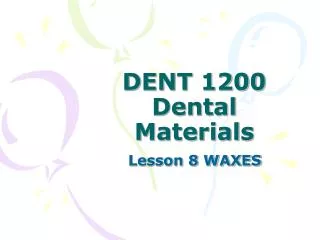
DENT 1200 Dental Materials
DENT 1200 Dental Materials . Lesson 8 WAXES. 1. Ingredients, Form, Use, Melting. Processing waxes- Boxing, Utility, Sticky Pattern waxes- Inlay/Casting, Baseplate Impression waxes- Bite registration, Study.
292 views • 14 slides
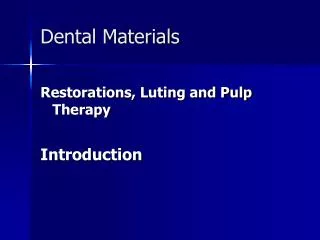
Dental Materials
Dental Materials. Restorations, Luting and Pulp Therapy Introduction. Restorations : A restoration is a material which substitutes the missing tooth structure and restores the form and function of the tooth . Types of Restorations .
766 views • 30 slides
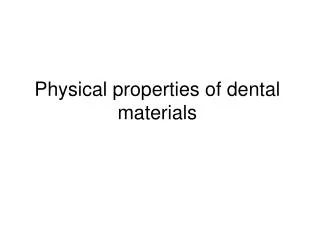
Physical properties of dental materials
Physical properties of dental materials. The elements of study. Physical properties include: 1-density 2-thermal properties 3-electrical properties 4-optical properties. Density:. Density is the mass per unite volume of the material .its units are gm/cm³ and pound/in³.
1.91k views • 47 slides

Introduction to Dental Materials
Introduction to Dental Materials. Three basic classes of materials : Metals Polymers Ceramics. Metals. At the atomic level , the atoms are bonded together by metallic bond. -metallic luster. -excellent electrical and thermal conductivity. -ability to be shaped (malleability).
605 views • 23 slides

Physical Properties of Dental Materials
Physical Properties of Dental Materials. These are properties which are not related to force application . These are: 1- Mass-related properties: Density 2- Thermal properties: - Thermal conductivity - Coefficient of thermal expansion and contraction
3.95k views • 37 slides
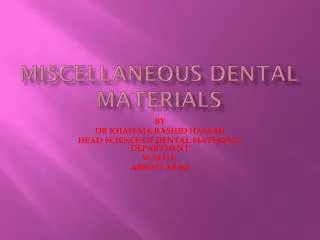
MISCELLANEOUS DENTAL MATERIALS
MISCELLANEOUS DENTAL MATERIALS. BY DR KHAWAJA RASHID HASSAN HEAD SCIENCE OF DENTAL MATERIALS DEPARTMENT W.M.D.C ABBOTTABAD. MISCELLANEOUS DENTAL MATERIALS. Materials used in MAXILLOFACIAL SURGERY. Materials used in ENDODONTICS. Materials used in PERIODONTICS. Maxillofacial materials.
916 views • 23 slides
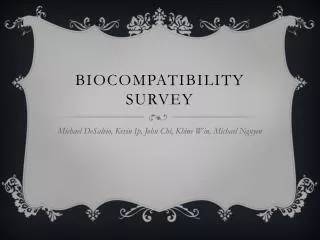
Biocompatibility Survey
Biocompatibility Survey. Michael DeSalvio , Kevin Ip , John Chi, Khine Win, Michael Nguyen. Polyurethane. Properties Cheap Durable Strong High stress and strain (More tear-resistant than rubber) Uses Tubing: catheters, dialysis, sutures, artificial heart valves
264 views • 6 slides
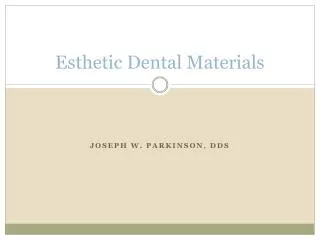
Esthetic Dental Materials
Esthetic Dental Materials. Joseph W. Parkinson, DDS. Esthetic Dental Materials. Single -Component Systems-Homogeneous material Feldspathic Porcelain Reinforced glass ceramics Pressed Ceramics Structural Limitations Need support from tooth structure Restricts to veneers, inlays, onlays.
546 views • 33 slides
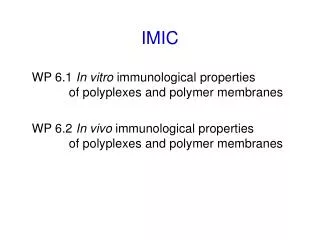
Biocompatibility and immunocompatibility
IMIC WP 6.1 In vitro immunological properties of polyplexes and polymer membranes WP 6.2 In vivo immunological properties of polyplexes and polymer membranes. Biocompatibility and immunocompatibility. Screening 1. Hemolysis (human red blood cells)
217 views • 7 slides

Sensor Biocompatibility
Sensor Biocompatibility. By: Shantel Shaver Mentor: Jeffery La Belle School of Biological Health and Systems Engineering. The Problem. Continuous Stress Assessment TBI, food deprivation, strenuous exercise and diabetic or pre-diabetic tendencies.
337 views • 15 slides

Biocompatibility
Biocompatibility. Biological response Biocompatibility tests Sterilization Issues. Biocompatibility. Arises from differences between living and non-living materials Bioimplants trigger inflammation or foreign body response
693 views • 6 slides
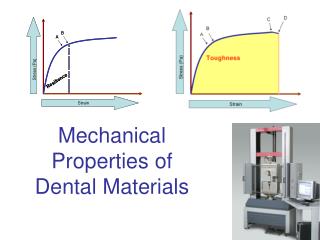
Mechanical Properties of Dental Materials
Mechanical Properties of Dental Materials. Occlusal forces. Average occlusal forces for fully dentate patients : 150 Newton in the anterior region to 500N in posterior region Maximum occlusal forces: different reports in the literature up to 3500N.
2.45k views • 47 slides

Dental Materials
Dental Materials. Restorations, Luting and Pulp Therapy Introduction. Restorations : A restoration is a material which substitutes the missing tooth structure and restores the form and function of the tooth. Types of Restorations.
785 views • 30 slides
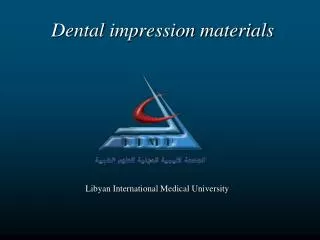
Dental impression materials
Dental impression materials. Libyan International Medical University. Introduction, types, classification. What is a dental impression?. It’s a negative likeness of the teeth and/or other tissues of the oral cavity.
2.13k views • 106 slides

DENT 1200 Dental Materials
DENT 1200 Dental Materials. Lesson 8 WAXES. 1. Ingredients, Form, Use, Melting. Processing waxes- Boxing, Utility, Sticky Pattern waxes- Inlay/Casting, Baseplate Impression waxes- Bite registration, Study.
466 views • 14 slides

Dental Materials
Dental Materials. Types Of the Cements Introduction. Silicate cements were introduced in 1903 as anterior esthetic filling materials. They are translucent . Silicates are attacked by oral fluids and in time degrade. The average life of a silicate restoration is four years. 1- 25 years.
1.3k views • 40 slides
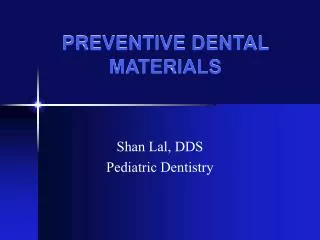
PREVENTIVE DENTAL MATERIALS
PREVENTIVE DENTAL MATERIALS. Shan Lal, DDS Pediatric Dentistry. Preventive Dental Materials. Tooth Paste Mouth Washes Fluorides Sealants Mouth guards. Tooth Paste. Components/composition Colloidal binding agents - Na Alginate, methy cellulose
1.3k views • 34 slides

Dental MAterials
Dental MAterials. Bleaching- VITAL. 3 techniques In office (heat/light) At Home (trays) Over the counter. Remove Extrinsic stain by applying carbamide PEROXIDE (10,16, 22%) topically Oxygen enters tooth and lightens. 1. Describe the process of bleaching. In Office bleaching.
507 views • 13 slides
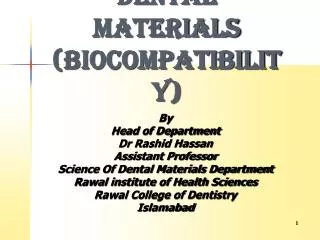
BIOLOGICAL PROPERTIES OF DENTAL MATERIALS (BIOCOMPATIBILITY)
BIOLOGICAL PROPERTIES OF DENTAL MATERIALS (BIOCOMPATIBILITY). By Head of Department Dr Rashid Hassan Assistant Professor Science Of Dental Materials Department Rawal institute of Health Sciences Rawal College of Dentistry Islamabad. BIOMATERIAL.
4.75k views • 32 slides

Dental Bio-Materials Market
The developing edentulous populace is anticipated to be a vital factor fueling the development of the worldwide dental biomaterials market all through the estimated time frame as individuals aged 60 years or more are at a higher threat of acquiring dental disorders
106 views • 7 slides
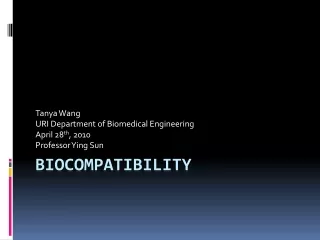
Biocompatibility
Tanya Wang URI Department of Biomedical Engineering April 28 th , 2010 Professor Ying Sun. Biocompatibility. Definition. Biocompatibility refers to:
225 views • 14 slides
























